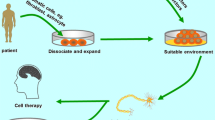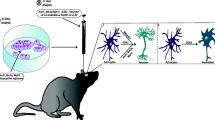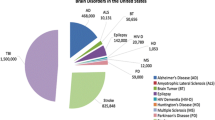Abstract
Recent research has shown that defined sets of exogenous factors are sufficient to convert rodent and human somatic cells directly into induced neural stem cells or neural precursor cells (iNSCs/iNPCs). The process of transdifferentiation bypasses the step of a pluripotent state and reduces the risk of tumorigenesis and genetic instability while retaining the self-renewing capacity. This iNSC/iNPC technology has fueled much excitement in regenerative medicine, as these cells can be differentiated into target cells for re placement therapy for neurodegenerative diseases. Patients’ somatic cell-derived iNSCs/iNPCs have also been proposed to serve as disease models with potential value in both fundamental studies and clinical applications. This review focuses on the mechanisms, techniques, and app lications of iNSCs/iNPCs from a series of related studies, as well as further efforts in designing novel strategies using iNSC/iNPC technology and its potential applications in neurodegenerative diseases.
Similar content being viewed by others
References
Kim J, Efe JA, Zhu S, Talantova M, Yuan X, Wang S, et al. Direct reprogramming of mouse fibroblasts to neural progenitors. Proc Natl Acad Sci U S A 2011, 108: 7838–7843.
Lujan E, Chanda S, Ahlenius H, Sudhof TC, Wernig M. Direct conversion of mouse fibroblasts to self-renewing, tripotent neural precursor cells. Proc Natl Acad Sci U S A 2012, 109: 2527–2532.
Sheng C, Zheng QY, Wu JY, Xu Z, Wang LB, Li W, et al. Direct reprogramming of Sertoli cells into multipotent neural stem cells by defined factors. Cell Res 2012, 22: 208–218.
Thier M, Worsdorfer P, Lakes YB, Gorris R, Herms S, Opitz T, et al. Direct Conversion of Fibroblasts into Stably Expandable Neural Stem Cells. Cell Stem Cell 2012, 10: 473–479.
Han DW, Tapia N, Hermann A, Hemmer K, Hoing S, Arauzo-Bravo MJ, et al. Direct Reprogramming of Fibroblasts into Neural Stem Cells by Defined Factors. Cell Stem Cell 2012, 10: 465–472.
Ring KL, Tong LM, Balestra ME, Javier R, Andrews-Zwilling Y, Li G, et al. Direct reprogramming of mouse and human fibroblasts into multipotent neural stem cells with a single factor. Cell Stem Cell 2012, 11: 100–109.
Corti S, Nizzardo M, Simone C, Falcone M, Donadoni C, Salani S, et al. Direct reprogramming of human astrocytes into neural stem cells and neurons. Exp Cell Res 2012, 318: 1528–1541.
Mitchell RR, Szabo E, Benoit YD, Case DT, Mechael R, Alamilla J, et al. Activation of Neural Cell Fate Programs Toward Direct Conversion of Adult Human Fibroblasts into Tri-Potent Neural Progenitors Using OCT-4. Stem Cell Dev 2014, 23: 1937–1946.
Zou QJ, Yan QM, Zhong J, Wang KP, Sun HT, Yi XL, et al. Direct conversion of human fibroblasts into neuronal restricted progenitors. J Biol Chem 2014, 289: 5250–5260.
Kim HS, Kim J, Jo Y, Jeon D, Cho YS. Direct lineage reprogramming of mouse fibroblasts to functional midbrain dopaminergic neuronal progenitors. Stem Cell Res 2014, 12: 60–68.
Yu KR, Shin JH, Kim JJ, Koog MG, Lee JY, Choi SW, et al. Rapid and efficient direct conversion of human adult somatic cells into neural stem cells by HMGA2/let-7b. Cell Rep 2015.
Azmitia L, Capetian P, Klett M, Dobrossy M, Nikkhah G. Directly reprogrammed neural precursors from patientspecific fibroblasts. Neuroreport 2014, 25: 139–139.
Zuryn S, Ahier A, Portoso M, White ER, Morin MC, Margueron R, et al. Transdifferentiation. Sequential histone-modifying activities determine the robustness of transdifferentiation. Science 2014, 345: 826–829.
Wapinski OL, Vierbuchen T, Qu K, Lee QY, Chanda S, Fuentes DR, et al. Hierarchical mechanisms for direct reprogramming of fibroblasts to neurons. Cell 2013, 155: 621–635.
Shimozaki K. Sox2 transcription network acts as a molecular switch to regulate properties of neural stem cells. World J Stem Cells 2014, 6: 485–490.
Graham V, Khudyakov J, Ellis P, Pevny L. SOX2 functions to maintain neural progenitor identity. Neuron 2003, 39: 749–765.
Jerabek S, Merino F, Scholer HR, Cojocaru V. OCT4: dynamic DNA binding pioneers stem cell pluripotency. Biochim Biophys Acta 2014, 1839: 138–154.
Miyoshi G, Fishell G. Dynamic FoxG1 Expression Coordinates the Integration of Multipolar Pyramidal Neuron Precursors into the Cortical Plate. Neuron 2012, 74: 1045–1058.
Regad T, Roth M, Bredenkamp N, Illing N, Papalopulu N. The neural progenitor-specifying activity of FoxG1 is antagonistically regulated by CKI and FGF. Nat Cell Biol 2007, 9: 531–540.
Brancaccio M, Pivetta C, Granzotto M, Filippis C, Mallamaci A. Emx2 and Foxg1 inhibit gliogenesis and promote neuronogenesis. Stem Cells 2010, 28: 1206–1218.
Fasano CA, Phoenix TN, Kokovay E, Lowry N, Elkabetz Y, Dimos JT, et al. Bmi-1 cooperates with Foxg1 to maintain neural stem cell self-renewal in the forebrain. Genes Dev 2009, 23: 561–574.
Kerosuo L, Piltti K, Hayry V, Fox H, Sariola H, Wartiovaara K. C-myc increases stemness of neural progenitor cells. International J Dev Neurosci 2006, 24: 521–521.
MuhChyi C, Juliandi B, Matsuda T, Nakashima K. Epigenetic regulation of neural stem cell fate during corticogenesis. Int J Dev Neurosci 2013, 31: 424–433.
Cortese R, Lewin J, Backdahl L, Krispin M, Wasserkort R, Eckhardt F, et al. Genome-wide screen for differential DNA methylation associated with neural cell differentiation in mouse. PLoS One 2011, 6: e26002.
Faigle R, Song H. Signaling mechanisms regulating adult neural stem cells and neurogenesis. Biochim Biophys Acta 2013, 1830: 2435–2448.
Jaenisch R, Young R. Stem cells, the molecular circuitry of pluripotency and nuclear reprogramming. Cell 2008, 132: 567–582.
Zhang XM, Li QM, Su DJ, Wang N, Shan ZY, Jin LH, et al. RA induces the neural-like cells generated from epigenetic modified NIH/3T3 cells. Mol Biol Rep 2010, 37: 1197–1202.
Dai JP, Lu JY, Zhang Y, Shen YF. Jmjd3 activates Mash1 gene in RA-induced neuronal differentiation of P19 cells. J Cell Biochem 2010, 110: 1457–1463.
Burgold T, Spreafico F, De Santa F, Totaro MG, Prosperini E, Natoli G, et al. The histone H3 lysine 27-specific demethylase Jmjd3 is required for neural commitment. PLoS One 2008, 3: e3034.
Zhu S, Ambasudhan R, Sun W, Kim HJ, Talantova M, Wang X, et al. Small molecules enable OCT4-mediated direct reprogramming into expandable human neural stem cells. Cell Res 2013, 24: 126–129.
Stappert L, Roese-Koerner B, Brustle O. The role of microRNAs in human neural stem cells, neuronal differentiation and subtype specification. Cell Tissue Res 2015, 359: 47–64.
Xue YC, Ouyang KF, Huang J, Zhou Y, Ouyang H, Li HR, et al. Direct Conversion of fibroblasts to neurons by reprogramming PTB-regulated microRNA circuits. Cell 2013, 152: 82–96.
Sun AX, Crabtree GR, Yoo AS. MicroRNAs: regulators of neuronal fate. Curr Opin Cell Biol 2013, 25: 215–221.
Shibata M, Nakao H, Kiyonari H, Abe T, Aizawa S. MicroRNA-9 regulates neural progenitor proliferation and differentiation in both pallium and subpallium by targeting Foxg1, Nr2e1, Gsh2 and Meis2. Dev Biol 2010, 344: 493–494.
Sun G, Yu RT, Evans RM, Shi Y. Orphan nuclear receptor TLX recruits histone deacetylases to repress transcription and regulate neural stem cell proliferation. Proc Natl Acad Sci U S A 2007, 104: 15282–15287.
Shi Y, Sun G, Zhao C, Stewart R. Neural stem cell self-renewal. Crit Rev Oncol Hematol 2008, 65: 43–53.
Collu GM, Hidalgo-Sastre A, Acar A, Bayston L, Gildea C, Leverentz MK, et al. Dishevelled limits Notch signalling through inhibition of CSL. Development 2012, 139: 4405–4415.
Xu XL, Yang JP, Fu LN, Ren RT, Yi F, Suzuki K, et al. Direct reprogramming of porcine fibroblasts to neural progenitor cells. Protein Cell 2014, 5: 4–7.
Maucksch C, Firmin E, Butler-Munro C, Montgomery J, Dottori M, Connor B. Non-viral generation of neural precursor-like cells from adult human fibroblasts. J Stem Cells Regen Med 2012, 8: 162–170.
Yakubov E, Rechavi G, Rozenblatt S, Givol D. Reprogramming of human fibroblasts to pluripotent stem cells using mRNA of four transcription factors. Biochem Biophys Res Commun 2010, 394: 189–193.
Lu J, Liu H, Huang CT, Chen H, Du Z, Liu Y, et al. Generation of integration-free and region-specific neural progenitors from primate fibroblasts. Cell Rep 2013, 3: 1580–1591.
Cheng L, Hu W, Qiu B, Zhao J, Yu Y, Guan W, et al. Generation of neural progenitor cells by chemical cocktails and hypoxia. Cell Res 2014, 24: 665–679.
Cai YN, Yuan XD, Ou Y, Lu YH. Apopt osis during beta-mercaptoethanol-induced differentiation of adult adipose-derived stromal cells into neurons. Neural Regen Res 2011, 6: 750–755.
Liu X, Shan W, Zeng RX, Fang Y, Li DH, Qin SJ. Differentiation of rat bone marrow mesenchymal stem cells into neuron-like cells induced by lycium barbarum polysaccharide. J Clin Rehabil Tissue Eng Res 2009, 13: 2667–2672.
Wang Y, Lu CQ, Wang F. Differentiatio n of rat bone marrow stromai stem cells into neuron-like cells induced by salvia mitiorrhiza. Chin J Anatomy 2007, 30: 207–210.
Du HY, Fu HY, Bao CF, Liu YZ, Qin SJ. Study on differentiation of rat bone marrow mesenchymal stem cells into neuron-like cells induced by rehmannia glutinosa polysaccharide in vitro. Chin J Exp Tradit Med Formulae 2012, 18: 133–137.
Yang J, Wang D. Study on the mediating role of PNS in bone marrow mesenchymal stem cells differentiating into neuronlike cells. Chinese Archives Tradit Chin Med 2012, 30: 891–893.
Chen B, Yin YQ, Ke JL, Zou XH, Peng H, Tan SF, et al. Ligustrazine induces rat bone morrow mesenchymal stem cells to differentiate into neuron-like cells: Screening of the optimal inductive concentration. J Clin Rehabil Tissue Eng Res 2010, 14: 1072–1077.
Pei JJ, Wu R, Zhao HB, Liu X, Hu J, Bai M H. Ca2+signaling mediated salidrosides promotes directional differentiation of mouse bone marrow mesenchymal stem cells into nerve cells. J Clin Rehabil Tissue Eng Res 2010, 14: 1809–1812.
Peruzzotti-Jametti L, Mallucci G, Tannahill G, Huang B, Lakes YB, Giusto E, et al. Injection of next-generation directly-induced neural stem cells (iNSCs) induces recovery in a mouse model of multiple sclerosis. J Neuroimmun 2014, 275: 193–193.
Glavaski-Joksimovic A, Virag T, Chang QA, West NC, Mangatu TA, McGrogan MP, et al. Reversal of dopaminergic degeneration in a parkinsonian rat following micrografting of human bone marrow-derived neural progenitors. Cell Transplant 2009, 18: 801–814.
Meyer K, Ferraiuolo L, Miranda CJ, Likhite S, McElroy S, Renusch S, et al. Direct conversion of patient fibroblasts demonstrates non-cell autonomous toxicity of astrocytes to motor neurons in familial and sporadic ALS. Proc Natl Acad Sci U S A 2014, 111: 829–832.
Mirakhori F, Zeynali B, Salekdeh GH, Baharvand H. Induced neural lineage cells as repair kits: so close, yet so far away. J Cell Physiol 2014, 229: 728–742.
Hong E, Choi Y, Yang H, Kang HY, Ahn C, Jeung E. Establishment of a rapid drug screening system based on embryonic stem cells. Environ Toxicol Pharmacol 2014, 39: 327–338.
Shi Y. Induced pluripotent stem cells, new tool s for drug discovery and new hope for stem cell therapies. Curr Mol Pharmacol 2009, 2: 15–18.
Lachmann N, Brennig S, Pfaff N, Schermeier H, Dahlmann J, Phaltane R, et al. Efficient in vivo regulation of cytidine deaminase expression in the haematopoietic system using a doxycycline-inducible lentiviral vector system. Gene Therapy 2013, 20: 298–307.
Ruggieri M, Riboldi G, Brajkovic S, Bucchia M, Bresolin N, Comi GP, et al. Induced neural stem cells: Methods of reprogramming and potential therapeutic applications. Prog Neurobiol 2014, 114: 15–24.
Author information
Authors and Affiliations
Corresponding author
Rights and permissions
About this article
Cite this article
Shen, T., Pu, J., Zheng, T. et al. Induced neural stem/precursor cells for fundamental studies and potential application in neurodegenerative diseases. Neurosci. Bull. 31, 589–600 (2015). https://doi.org/10.1007/s12264-015-1527-z
Received:
Accepted:
Published:
Issue Date:
DOI: https://doi.org/10.1007/s12264-015-1527-z




